The Shrimp Nebula is a planetary nebula located more than 2,000 light years away in the northern constellation Cassiopeia. It is catalogued as Sharpless 188 (Sh2-188) in the Sharpless catalogue of H II regions and sometimes also called the Dolphin Nebula or the Firefox Nebula. The evolved nebula has an estimated age of 22,500 years.
Sharpless 188 lies in the region of Cassiopeia’s W. It has an apparent magnitude of 17.447. With a diameter of around 9 light-years (2.8 parsecs), it is one of the largest planetary nebulae known. The crescent-shaped nebula has a total angular size of 15 arcminutes. The bright semi-circular arc in the southeast has a diameter of 10 arcminutes.
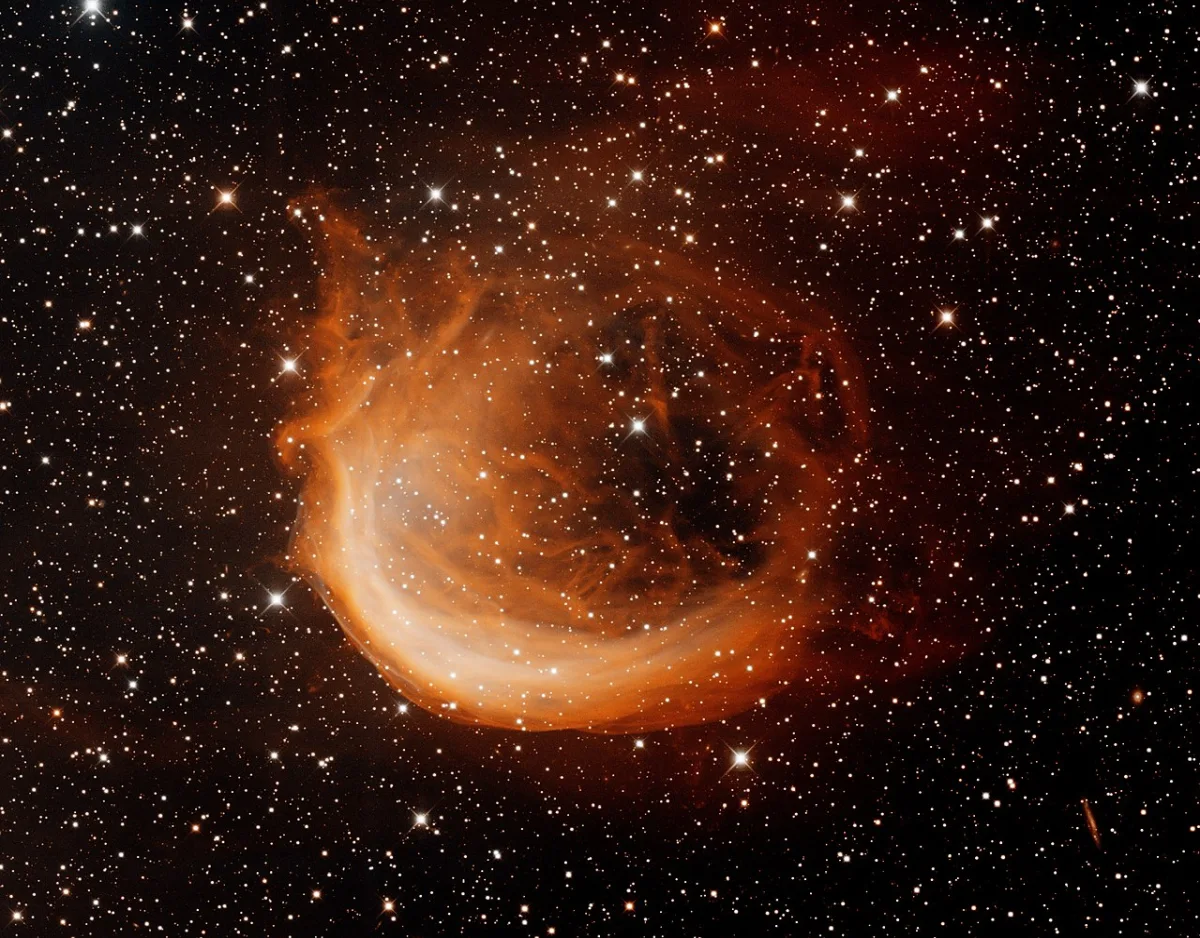
This image shows off the impressive imaging capabilities of the new CCD detectors in the Mosaic 1.1 camera on the Mayall 4-meter telescope at Kitt Peak National Observatory. The image is of Sharpless 2-188 (Sh2-188), an unusual planetary nebula located in the constellation Cassiopeia. The expanding gas from the planetary nebula is colliding with ambient gas in the interstellar medium. The nebula is nearly circular in shape but is much brighter to the southeast (lower left) because the central star is moving rapidly in that direction. Faint wisps of gas can also be seen in the opposite direction. The image was generated with deep observations in the Hydrogen alpha filter (red) and the Oxygen [OIII] filter (cyan). In this image, North is up and East is to the left. Image credit: T.A. Rector/University of Alaska Anchorage, H. Schweiker/WIYN and NOIRLab/NSF/AURA (CC BY 4.0)
Sharpless 188 unusually asymmetrical for a planetary nebula. Even though it is circular or elliptical in shape, one side of the nebula is much brighter than the other. This is believed to be the effect of the nebula’s expanding shell interacting with a pre-existing bow shock that formed when the central star was in an earlier phase of evolution. The nebula’s motion through the interstellar medium is directed towards the bright southeastern rim and consistent with the central star’s proper motion.
Planetary nebulae form when stars similar to the Sun eject their outer layers into space. The clouds of expelled gaseous material are then ionized by the energetic ultraviolet radiation of the exposed stellar core. Ring-like structure in planetary nebulae is produced by the interaction of the slow wind produced when the central star was on the asymptotic giant branch (AGB) with the fast wind from the hot star.
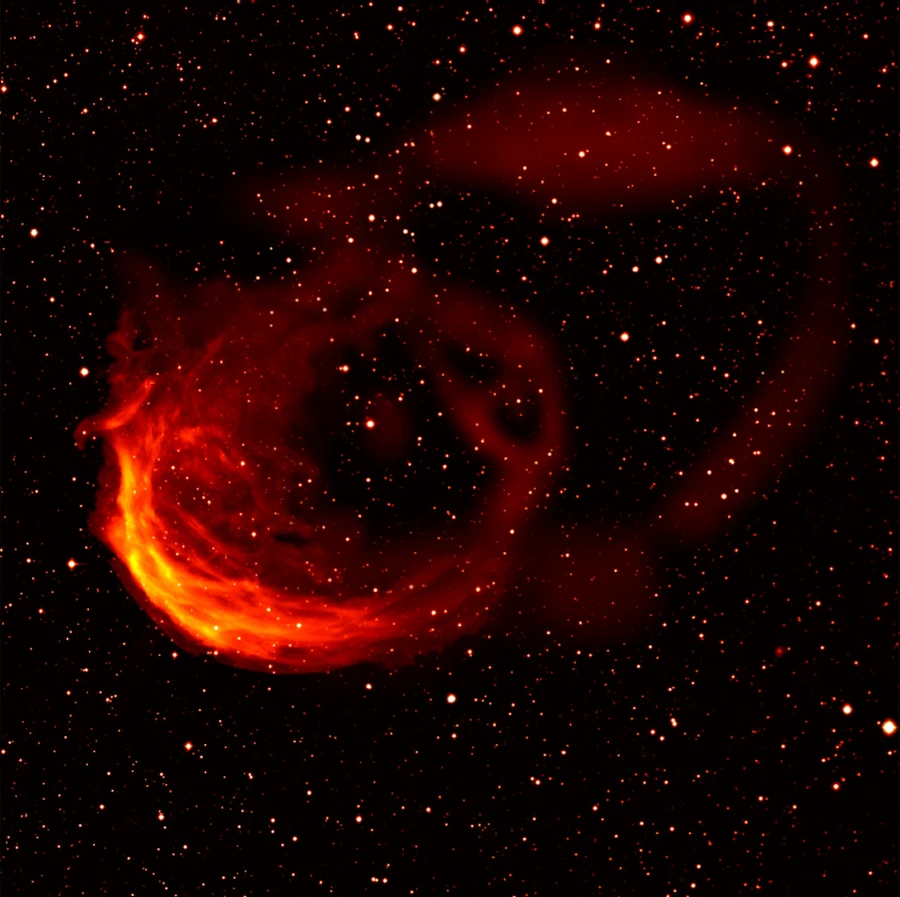
The central star of Sharpless 2-188 is travelling at 125 kilometres per second across the sky. Observations show a strong brightening in the direction in which the star is moving and faint material stretching away in the opposite direction. Astronomers believe that the bright structures in the arc observed ahead of Sh2-188 are bow shock instabilities, which will form whirlpools as they spiral past the star downstream to the tail. The image was obtained as part of the INT/WFC Photometric Hydrogen-Alpha Survey of the Northern Galactic Plane (IPHAS). Image credit: Nick Wright and the IPHAS collaboration (CC BY 4.0)
The inner regions of the slow-moving wind are compressed into a dense bubble, which is then ionized by the central star to produce the appearance of a bright ring. Details and asymmetries in the structure of planetary nebulae depend on the properties of the progenitor star, the possible presence of a companion, and asymmetries in the slow wind.
In the case of the Shrimp Nebula, the unusual morphology is attributed to the central star moving through space at high speed. Simulations have shown that, to produce the observed nebula, the central star would need to ram through space with a velocity of 125 km s-1 relative to the interstellar medium. The nebula’s bright limb and faint tail are believed to have formed when the central star was still on the AGB, experiencing accelerated mass loss in the form of a strong stellar wind.
Wareing et al. proposed a “triple wind” model for the formation of Sh2-188. In addition to the usual fast and slow winds, the astronomers suggested that the nebula’s bow shape was affected by the wind produced due to the star’s fast motion through the interstellar medium.
The distance to Sharpless 188 is uncertain. Different studies have given values of around 2,381 and 2,772 light years (730 and 850 parsecs), with large margins of error. Studies have also placed the central star 1,957 light-years (600 pc) away or 3,147 ly (965 pc) away.
The central star of Sh2-188 is a white dwarf catalogued as WD 0127+581. It has the spectral type DAO.6, indicating a stellar remnant that is rich in hydrogen and helium and shows lines of ionized helium.
The central star of Sharpless 188 was identified by Kwitter et al. based on observations at the Kitt Peak National Observatory in 1988. The star is clearly offset from the nebula’s centre. In images of the nebula, it is not one of the brighter stars in the nebula’s central region. It appears between the nebula’s centre and the bright rim in the southeast. The star has an estimated temperature of 102,000 K. A 2012 study proposed that the star may have a binary companion, a red dwarf of the spectral type M8V – M4V.
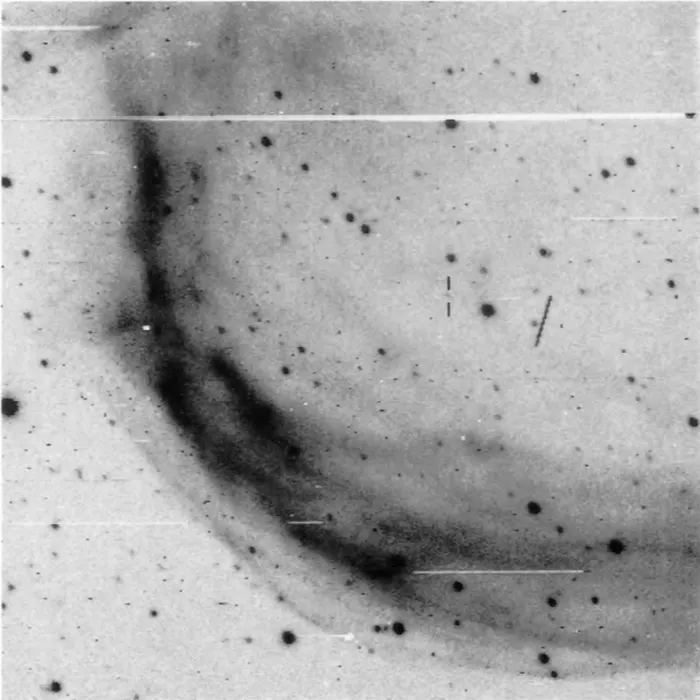
The central star of Sh2-188, image credit: Kwitter et al. (CC BY 4.0)
Facts
The Shrimp Nebula was discovered by astronomers Grigory Abramovich Shajn and Vera Fedorovna Gaze at the Simeiz Observatory on the Crimean Peninsula in the early 1950s. It was catalogued as Simeiz 22 (Simeis 22).
American astronomer Stewart Sharpless found the nebula independently and included it as Sharpless 188 (Sh2-188) in his catalogue of H II regions of 1959. Sharpless discovered the nebula on photographic plates obtained with the 48-inch Schmidt telescope as part of the Palomar Observatory Sky Survey. He noted the nebula’s similarity to the better-known Medusa Nebula (Sharpless 274) in the constellation Gemini.
The Shrimp Nebula was originally believed to be a supernova remnant because of its large size and filamentary structure.
In 1958, German-American astronomer Rudolph Minkowski discussed the nebula as a possible supernova remnant. Harris (1962), Parker (1964) and Lozinskaya (1970) also identified it as an SNR. In 1973, Georgelin et al. accepted the nebula as an H II region.
In 1978, observations with the Westerbork Synthesis Radio Telescope ruled out the possibility that the nebula was a supernova remnant. The astronomers estimated a probable mass of only a few hundredths of a solar mass for the nebula and concluded it was the result of moderate mass loss from the central star.
In 1982, Rosado and Kwitter studied Sh2-188 as a planetary nebula based on its observed nebular spectrum. They found an expansion velocity of 44 km s-1 and gave a distance estimate of 0.74 kiloparsecs (2,414 light-years).
Sharpless-188 has several other nicknames. It has been called the Dolphin Nebula or the Prawn Nebula due to its shape, and the Firefox Nebula due to its resemblance to the Firefox browser logo. It is not to be mistaken for the Prawn Nebula (IC 4628), an emission nebula in the constellation Scorpius.
The Shrimp Nebula and the Prawn Nebula are not the only crustacean-shaped nebulae in the sky. Others include the famous Crab Nebula (Messier 1), a bright remnant of a historic supernova in the constellation Taurus, the Southern Crab Nebula (Henize 2-104) in Centaurus, and the Lobster Claw Nebula (NGC 6357) in Scorpius.
Location
The Shrimp Nebula is easy to find because it lies close to Cassiopeia’s W, one of the most recognizable asterisms in the northern sky. It appears near Ruchbah (Delta Cassiopeiae), close to the magnitude 4.7 yellow giant Chi Cassiopeiae.
Sharpless 188 appears in the same area as the bright open cluster NGC 457. Popularly known as the Owl Cluster or the E. T. Cluster, NGC 457 lies about 2 degrees from Ruchbah. It shines at magnitude 6.4 from a distance of 7,900 light-years and can be seen in binoculars. The Shrimp Nebula appears just east of the cluster, 22 arcminutes west of the orange supergiant HD 9352 (HR 439, mag. 5.7).
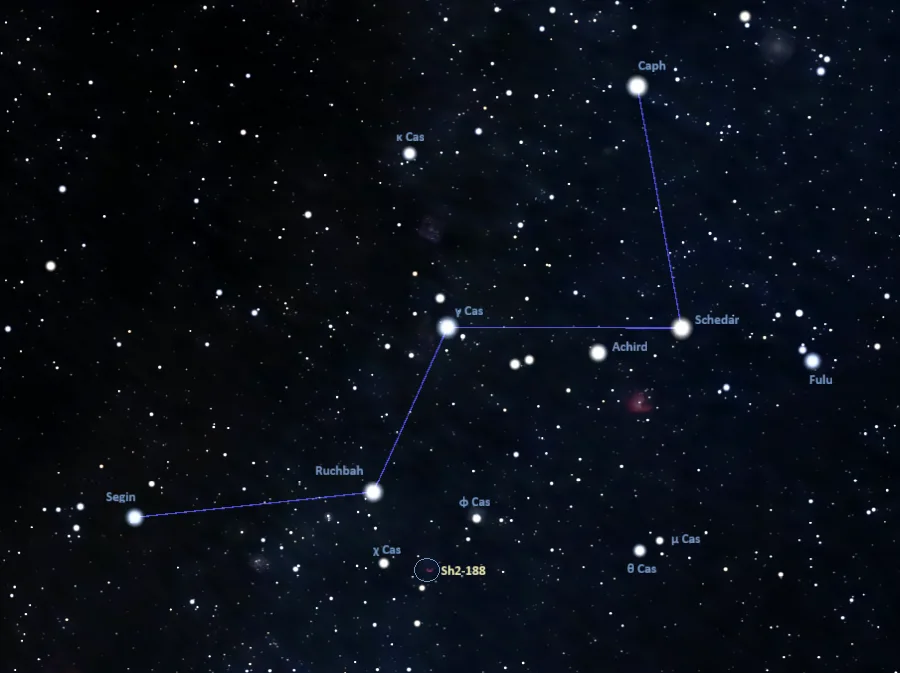
Shrimp Nebula location, image: Stellarium
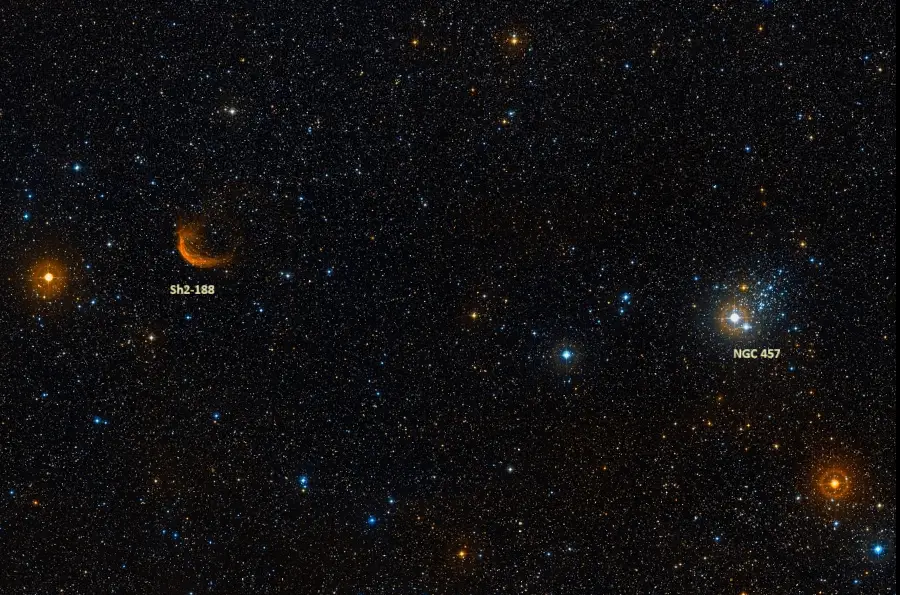
The Shrimp Nebula (Sh2-188) and the Owl Cluster (NGC 457), image credit: ESO/Digitized Sky Survey 2 (CC BY 4.0)
Unlike the bright Owl Cluster, Sh2-188 is a very challenging target for backyard telescopes. The nebula appears very faint and small and may be spotted in large telescopes using filters on an exceptionally clear, dark night from areas without light pollution. It is best seen in long-exposure photographs.
Sharpless 188 is best seen from the northern hemisphere. It never rises for observers south of the latitude 32° S. The best time of the year to observe deep sky objects in Cassiopeia is during the month of November, when the constellation is high above the horizon around 9 pm.
Shrimp Nebula – Sh2-188
| Constellation | Cassiopeia |
| Object type | Planetary nebula |
| Right ascension | 01h 30m 33.1778575512s |
| Declination | +58° 24′ 50.325485868″ |
| Apparent magnitude | 17.447 |
| Apparent size | 15′ |
| Distance | 2,381 ± 783 light-years (730 ± 240 parsecs), or 2,772 light-years (1,402 – 4,403 ly); 850 parsecs (430 – 1,350 pc) |
| Size | 9 light years (2.8 pc) |
| Names and designations | Shrimp Nebula, Dolphin Nebula, Firefox Nebula, Sharpless 188, Sh2-188, S188, LBN 633, LBN 128.04-04.12, Simeis 22, Simeiz 22, Sim 22, PN G128.0-04.1, PK 128-04 1, WD 0127+581, GSC2 N311302026110, [GS55] 12, Gaia DR2 509206447837376128, Gaia DR3 509206447837376128 |